Contents
1. Prism Problem
apex_deg=60; apex=apex_deg*pi/180; lambda=500e-9; % Meters lambda_um=lambda*1e6; % http://refractiveindex.info/?shelf=glass&book=SF10&page=SCHOTT n=sqrt(1+(1.62153902*lambda_um.^2)./(lambda_um.^2-0.0122241457)+... (0.256287842*lambda_um.^2)./(lambda_um.^2-0.0595736775)+... (1.64447552*lambda_um.^2)./(lambda_um.^2-147.468793)) deltamin=2*asin(n*sin(apex/2))-apex; deltamin_deg=deltamin*180/pi % 11945/slides2r3-52 theta1=asin(n*sin(apex/2)); % 11945/slides2r3-52 theta1_deg=theta1*180/pi
n =
1.7432
deltamin_deg =
61.2845
theta1_deg =
60.6423
Calculation for all wavelengths
lambda=[400:100:1500]*1e-9; lambda_um=lambda*1e6; % http://refractiveindex.info/?shelf=glass&book=SF10&page=SCHOTT n=sqrt(1+(1.62153902*lambda_um.^2)./(lambda_um.^2-0.0122241457)+... (0.256287842*lambda_um.^2)./(lambda_um.^2-0.0595736775)+... (1.64447552*lambda_um.^2)./(lambda_um.^2-147.468793)); sintheta1prime=sin(theta1); sintheta2prime=sqrt(n.^2-sin(theta1)^2)*sin(apex)-... sintheta1prime*cos(apex); % 11945/slides2r3-51 theta2prime=asin(sintheta2prime); delta=theta1+theta2prime-apex; % 11945/slides2r3-51 figure;plot(lambda*1e9,delta*180/pi,'-o');grid on; xlabel('\lambda, Wavelength, nm'); ylabel('\delta, Deviation, deg'); % clear;
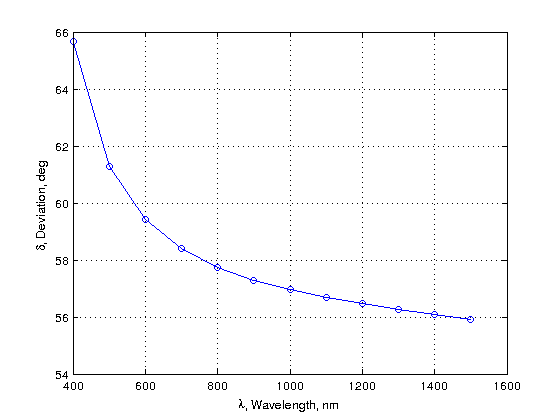
2. Negative Lens Problem
f=-1; % Focal length in m s=[2:40]; sprime=1./(1/f-1./s); % sprime is always negative: Virtual image figure;plot(s,sprime);grid on; % Image distance xlabel('s, Object Distance, m'); ylabel('s'', Image Distance, m');
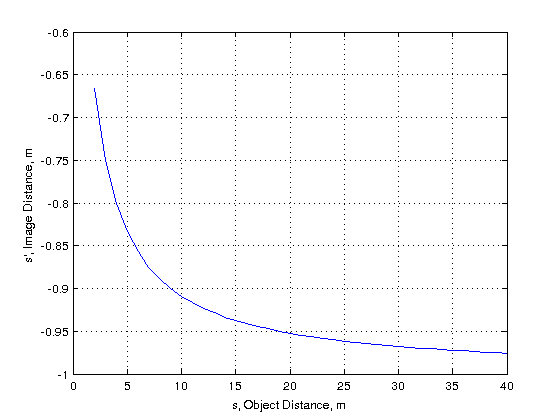
Magnification
m=-sprime./s;m_z=-m.^2; % m_z is ds'/ds figure;plot(s,m,'b-',s,m_z,'g--');grid on; % Magnification xlabel('s, Object Distance, m'); ylabel('m, m_z, Magnifications'); legend('m','m_z'); % At least 3:1 compression in the z direction, getting worse with % increasing distance. clear;
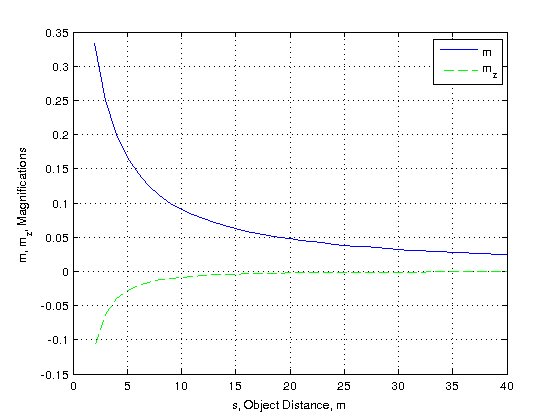
3. Scanner Problem
stop diameter NA = sin(theta)
M=10;NA=0.53; ftube=160; fobjective=ftube/M; theta=asin(NA);d_pupil=2*fobjective*tan(theta) % % FOV !!! Oops. That 20 should have been mm, not cm. That's an % insanely large field stop for a microscope. d_fieldstop=20; FOV=d_fieldstop/M
d_pupil =
20.0001
FOV =
2
Scanning part
fs=1:200; % Focal length of scanner lens thetad=atand(d_fieldstop/2./fs); % Need to scan +/- this angle dpupil_at_mirror=d_fieldstop*fs/ftube; figure;plot(dpupil_at_mirror,thetad); grid on; xlabel('Diameter at Scanner'); ylabel('Scan Half Angle, Deg.'); % Pick 20 degrees and about 3.44 mm diameter
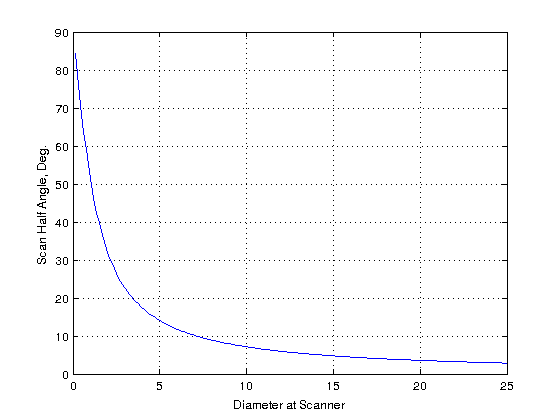
Find the fs needed
figure;plot(fs,thetad); grid on; xlabel('f_s, Focal Length of Scanner Lens, mm'); ylabel('Scan Half Angle, Deg.'); % For this, f_s = 27.5 degrees (from plot) clear;
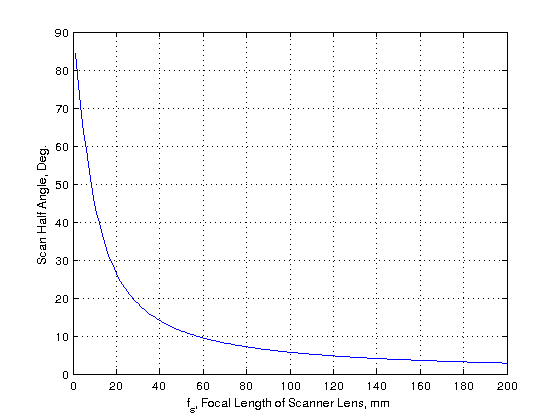
4. Aberrations
f1=0.05;f2=0.50;d1=f1/5;d2=f2/5; % Use meters s=1000;m=-f2/f1; sprime=-(f2/f1)^2*s-f1*m*(1+m) % Further away because we are using the telescope "backward" % % For lens 1, object distance is large and image is near the focus, so % use a plano-convex with the convex side toward the object. For lens % 2, the object is near the front focus and the image is far, so use % another plano-convex lens, but put the convex side toward the % object. The plane sides of the lenses are toward each other. % One of the principal planes is at the convex side, and the other is % one third the thickness away. th1=5e-3;th2=2e-2; % Distance between principal planes should be sum of focal length. % Distance between vertices is z_v1prime_v2 = f1+f2-th1*2/3-th2*2/3
sprime =
-1.0000e+05
z_v1prime_v2 =
0.5333
Spherical aberration
n=1.5; p1=-1;q1=1;p2=1;q2=-1; % 11945/slides5r1-28 ls1=(d1/2)^2/8/f1^3*1/(n*(n-1))*... ((n+2)/(n-1)*q1^2+4*(n+1)*p1*q1+(3*n+2)*(n-1)*p1^2+n^3/(n-1)); ls2=(d2/2)^2/8/f2^3*1/(n*(n-1))*... ((n+2)/(n-1)*q2^2+4*(n+1)*p2*q2+(3*n+2)*(n-1)*p2^2+n^3/(n-1)); ls=ls1+ls2 % Total spherical aberration in diopters equivalent_focal_length=1/ls
ls =
0.2567
equivalent_focal_length =
3.8961
Alternative Configuration
Now the image from the first lens (and object for the second) are at infinite distance. The original object and final image are close. Therefore we should place the lenses with convex sides toward each other. Then
z_v1prime_v2 = f1+f2 % % Both p and q reverse signs. p1=1;q1=-1;p2=-1;q2=1; % 11945/slides5r1-28 ls1=(d1/2)^2/8/f1^3*1/(n*(n-1))*... ((n+2)/(n-1)*q1^2+4*(n+1)*p1*q1+(3*n+2)*(n-1)*p1^2+n^3/(n-1)); ls2=(d2/2)^2/8/f2^3*1/(n*(n-1))*... ((n+2)/(n-1)*q2^2+4*(n+1)*p2*q2+(3*n+2)*(n-1)*p2^2+n^3/(n-1)); ls=ls1+ls2 % Total spherical aberration in diopters equivalent_focal_length=1/ls
z_v1prime_v2 =
0.5500
ls =
0.2567
equivalent_focal_length =
3.8961
Just for comparison, the wrong way,
p1=1;q1=1;p2=-1;q2=-1; % 11945/slides5r1-28 ls1=(d1/2)^2/8/f1^3*1/(n*(n-1))*... ((n+2)/(n-1)*q1^2+4*(n+1)*p1*q1+(3*n+2)*(n-1)*p1^2+n^3/(n-1)); ls2=(d2/2)^2/8/f2^3*1/(n*(n-1))*... ((n+2)/(n-1)*q2^2+4*(n+1)*p2*q2+(3*n+2)*(n-1)*p2^2+n^3/(n-1)); ls=ls1+ls2 % Total spherical aberration in diopters equivalent_focal_length=1/ls % four times the aberration
ls =
0.9900
equivalent_focal_length =
1.0101